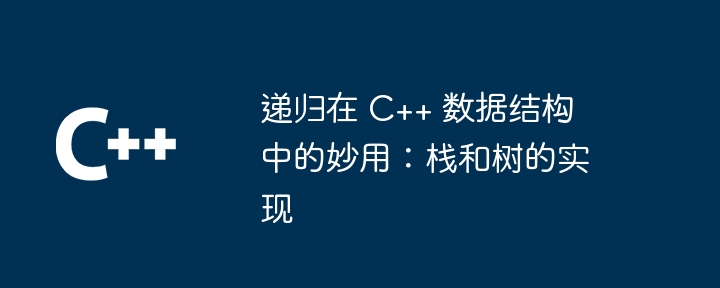C++ 데이터 구조에서 재귀의 놀라운 사용: 스택 및 트리 구현
- WBOYWBOYWBOYWBOYWBOYWBOYWBOYWBOYWBOYWBOYWBOYWBOYWB원래의
- 2024-05-04 13:54:011135검색
C++ 데이터 구조의 재귀 적용: 스택: 스택은 LIFO(후입선출) 구조를 통해 재귀적으로 구현됩니다. 트리(Tree): 트리는 계층적 구조를 통해 재귀적으로 구현되어 삽입, 깊이 계산 등의 작업을 지원합니다. 재귀는 중첩 구조 처리를 위한 간결하고 효율적인 솔루션을 제공하여 데이터 구조 구현을 보다 직관적이고 유지 관리하기 쉽게 만듭니다.

C++ 데이터 구조에서 재귀의 놀라운 활용: 스택과 트리 구현
재귀는 함수가 스스로를 호출하여 문제를 해결할 수 있게 해주는 강력한 프로그래밍 기술입니다. 재귀는 데이터 구조 구현, 특히 트리 구조 및 선형 구조 처리에 매우 유용합니다.
스택의 재귀 구현
스택은 LIFO(후입선출) 데이터 구조입니다. 아래와 같이 재귀를 사용하여 스택을 구현할 수 있습니다.
struct Node {
int data;
Node* next;
};
class Stack {
private:
Node* head;
public:
void push(int data) {
head = new Node{data, head};
}
int pop() {
if (head == nullptr) {
throw exception("Stack is empty");
}
int data = head->data;
head = head->next;
return data;
}
bool empty() {
return head == nullptr;
}
};실제 사례: 연결 목록을 역순으로 인쇄
void printLinkedListInReverseOrder(Node* head) {
if (head == nullptr) {
return;
}
printLinkedListInReverseOrder(head->next);
cout << head->data << " ";
}tree의 재귀 구현
Tree는 계층적 데이터 구조입니다. 아래와 같이 재귀를 사용하여 트리를 구현할 수 있습니다.
struct Node {
int data;
vector<Node*> children;
};
class Tree {
private:
Node* root;
public:
void insert(int data) {
if (root == nullptr) {
root = new Node{data, {}};
} else {
insertHelper(root, data);
}
}
private:
void insertHelper(Node* node, int data) {
for (auto& child : node->children) {
if (child == nullptr) {
child = new Node{data, {}};
return;
}
}
node->children.push_back(new Node{data, {}});
}
void printTree() {
printTreeHelper(root);
}
private:
void printTreeHelper(Node* node) {
cout << node->data << " ";
for (auto& child : node->children) {
printTreeHelper(child);
}
}
};실용 사례: 이진 트리의 깊이 계산
int calculateTreeDepth(Node* root) {
if (root == nullptr) {
return 0;
}
int maxDepth = 0;
for (auto& child : root->children) {
maxDepth = max(maxDepth, calculateTreeDepth(child));
}
return maxDepth + 1;
}재귀를 통해 스택, 트리 등 핵심 데이터 구조를 간결하고 효율적으로 구현할 수 있습니다. 재귀는 복잡한 중첩 구조를 처리하기 위한 강력한 도구를 제공하여 데이터 구조 구현을 보다 직관적이고 유지 관리하기 쉽게 만듭니다.
위 내용은 C++ 데이터 구조에서 재귀의 놀라운 사용: 스택 및 트리 구현의 상세 내용입니다. 자세한 내용은 PHP 중국어 웹사이트의 기타 관련 기사를 참조하세요!
성명:
본 글의 내용은 네티즌들의 자발적인 기여로 작성되었으며, 저작권은 원저작자에게 있습니다. 본 사이트는 이에 상응하는 법적 책임을 지지 않습니다. 표절이나 침해가 의심되는 콘텐츠를 발견한 경우 admin@php.cn으로 문의하세요.

